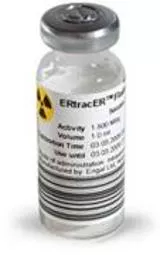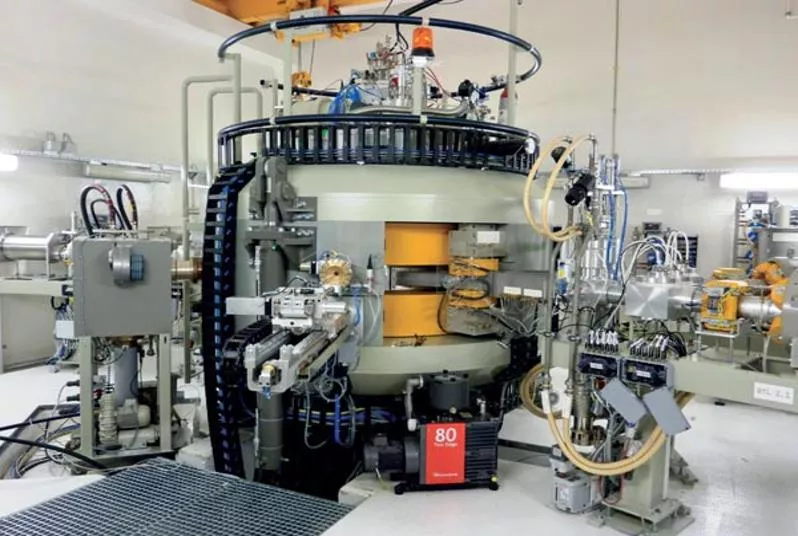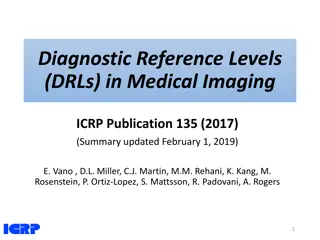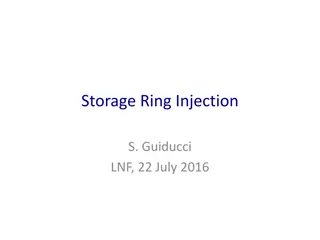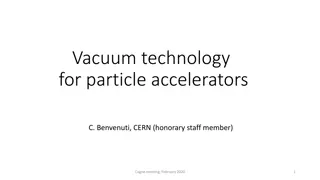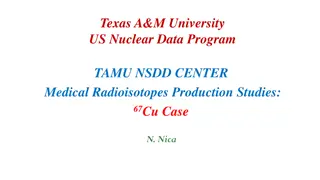Advancements in Radioisotope Production Using Linear Accelerators for Medical Imaging
Exploring the potential of linear accelerators for producing radioisotopes used in PET imaging, this comprehensive study delves into the efficiency and cost-effectiveness of utilizing linac-based systems. Key considerations include accelerator designs, production yield estimations, and numerical calculations for optimizing production processes. The development of innovative methods and the comparison with traditional cyclotron-based approaches highlight the significant advancements in the field of medical radioisotope production.
Download Presentation

Please find below an Image/Link to download the presentation.
The content on the website is provided AS IS for your information and personal use only. It may not be sold, licensed, or shared on other websites without obtaining consent from the author. Download presentation by click this link. If you encounter any issues during the download, it is possible that the publisher has removed the file from their server.
E N D
Presentation Transcript
Radioisotope production using linear accelerators A.Mamaras, MSc at AUTh Y. Foka, (GSI/CERN), . Liolios (AUTh) Thessaloniki, 6thNovember, 2020
Medical radioisotope production 18F-FDG From radioisotope 18F to the radiopharmaceutical FDG Main topic of bachelor thesis work was to investigate the possibility to use linear accelerators for the production of radioisotopes commonly used for PET imaging. The Cyclone 30 isotope-producing cyclotron, 8.3 tons Medical cyclotrons in dedicated facilities and transported to the hospitals for their use. radioisotopes are usually produced by The basic idea is to install a linac-based system for radioisotope production at or near the location where the radioisotopes are used, since linacs may offer many advantages compared to cyclotrons. Source: https://bit.ly/3l5ihdu
Possible RFQ Linac designs Source: https://bit.ly/3p0efFQ, M. Vretenar et al. Characteristics Characteristics Accelerator length 4 m Accelerator length 2.5 m Surface 15 m2 Surface 10 m2 Weight 500 kg Weight 350 kg Output Energy 10 MeV Output Energy 6.5 MeV Duty Cycle 10% Duty Cycle 4 % Power Consumption 350 kW Power Consumption 400 kW Operating Frequency 750 MHz Operating Frequency 750 MHz
Development of numerical calculations The production yield of18F commonly used for PET imaging was estimated in a certain range of energies together with the corresponding number of PET doses. Developed a method of numerical calculations for radioisotope production to: Search for an energy range in which we can achieve efficient radioisotope production Keep the setup compact and cost effective Investigate the possibility for injection to the synchrotron in the same energy range
Radionuclide Production Yield ?? ? ( ) ?? ? ? ? = ? 1 ? ? ? ?? ?? ?? ?? Yield ( mCi or GBq) Number of target atoms per unit volume Irradiation time decay constant of the radionuclide Beam current ( ) Eiis the beam energy, Ethis the reaction threshold energy, (E) is the excitation function, dE/dx is the stopping power of the target material. For practical reasons, saturation factor, , is considered at 3.5 T1/2of the radioisotope.
Development of numerical calculation for radioisotope production Obtain the range of the particle beam inside the target from the literature. We divide the range that the particles of the beam will reach, xmax, in the target in several thin slices of equal thickness x. Knowing the initial kinetic energy Einput= E1of the particle beam impinging on the first slice, we can get from the literature the value of the stopping power S1=S(E1) for this energy, which is valid in the whole slice, assuming that the stopping power is approximately constant for small variations of energy. The energy loss of particles passing this slice must be equal to E1= S1 x1, and the energy of particles exiting this slice and entering into the next will be equal to E2= E1- E1= E1- S1 x1. We proceed in the same way to the following slices, the particle energy in each slice is decreasing in small but unequal steps, until it reaches zero (in the figure this happens somewhere into the 8thslice).
Development of numerical calculation for radioisotope production In order to calculate the yield in each slice, yi, we need in addition the values of the cross section i= (Ei) for energy Eiof the particles in each slice. We need also the number of nuclei of the surface s density for each slice n = ( ?0 beam current I), the irradiation time t and the decay constant of the produced radioisotope. At the end, we find the yield as the sum of the yields in each slice: Y = yi. ?) x, the particle flux (i.e. the
Yield calculation for 18F production from H218O water target. Number of PET doses for 1 18F Saturation Activity for 1 9 25.0 8 20.0 7 6 Saturation activity [GBq] Number of PET doses 15.0 5 4 10.0 3 2 5.0 1 0 0.0 0 2 4 6 8 10 12 14 16 0 2 4 6 8 10 12 14 16 Beam energy [MeV] Beam energy [MeV]
Possible RFQ Linac designs Source: https://bit.ly/3p0efFQ, M. Vretenar et al. Saturation yield after 3.5 T1/2 6 h: 74 GBq 200 PET doses Saturation yield after 3.5 T1/2 6 h: 104 GBq 282 PET doses 18F arriving from Athens, by plane and/or car Great yield loss. The produced yield at the production laboratory is 120 GBq out of which only 15 GBq reach the hospital (after 5-6 hours) and 4.4 GBq are finaly used. This loss can be avoided with a production unit close to the hospital Possible linac setup designs.
Possibility of radioisotope production in SEEIIST facility Possibility for an extension to construct a unit dedicated to the extraction of the produced radioisotope from the target and the radiopharmaceuticals. production of The surplus of radioisotope quantities could available to other hospitals. be made Research field for exploring more promising radioisotopes for diagnostic and therapeutic purposes.
Conclusions and Outlook The possibility of using linacs for radioisotope production looks promising. Study the simultaneous optimization of the parameters needed for the production of these radioisotopes, by a compact cost effective linear accelerating system that could also be used for injection to the synchrotron. Optimize the design of this area including efficient radioprotection methods, shielding calculations and appropriate construction materials.
Thank you! Thank you!




